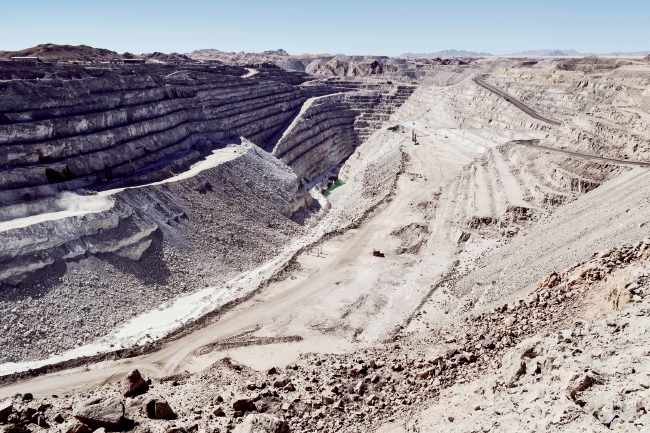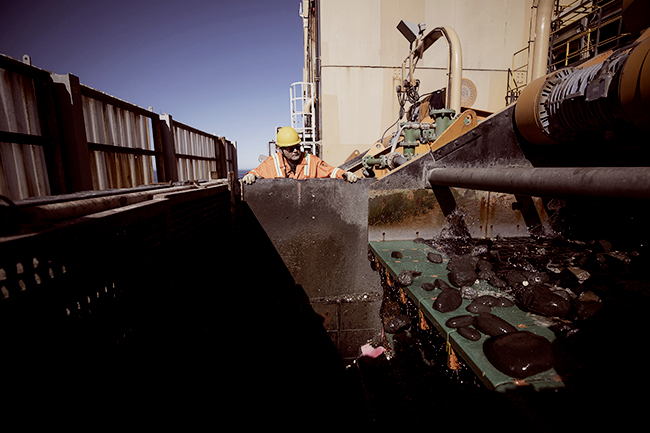There are few countries where mining is so critical to the overall health of the economy as Namibia. Although the mining sector makes up only 14% of GDP, it earns more than half of the country’s foreign exchange and, in 2018, contributed 24% of the total tax on profit. The biggest minerals sectors are gem diamonds, uranium and high-grade zinc. But the dominance of resources is, as always, a double-edged sword.
Namibia’s economy has stagnated in recent years with GDP contracting in both 2017 and 2018. The country has an unusually open economy and is thus vulnerable to global trading conditions. A soft uranium price and recent uncertainty over the future of Namdeb’s remaining terrestrial diamond mines have contributed to the problem. But junior mining is very active, with almost weekly announcements of activities by Canadian and Australian prospectors.
The uranium market has been especially volatile. The price of nuclear fuel has trended downward since its spike in 2007. But the bigger problem has been the global expansion in mine supply since low-cost Kazakh miners started production after 2001.
Kazakhstan produces 40% of the world’s uranium oxide. Most of the mineral is traded via three-to-15 year contracts and, because miners offer security of supply, the prices are higher than the spot market. However, as the World Nuclear Association notes, ‘production has risen much faster than demand (with the result that) fewer long-term contracts are being written’.
One of Namibia’s four main uranium mines – Langer Heinrich, 80 km inland from Walvis Bay – was placed on care and maintenance in May 2018. The owner, Paladin Energy, said it would consider reopening the operation when the international uranium market ‘normalises’.
The Windhoek Observer calculates that the shuttering of Langer Heinrich had a knock-on effect of US$32 million on suppliers that no longer had business from the mine. ‘Normalisation’ of the uranium oxide market may happen sooner rather than later. Two trends point in the direction of higher prices.
First, the popularity of nuclear reactors appears to have recovered after the drop in the wake of the Fukushima disaster in Japan in 2011. Some 50 reactors are currently under construction with another 100 planned and a further 300 proposed. It is quite possible that the world is returning to the rate of reactor construction seen in the halcyon days of the 1980s when a new nuclear reactor started up every 17 days.
Second, the uncertainties of the past few years have driven considerable production from the market. Combined with the Langer Heinrich closure, mine shut-downs in Kazakhstan and Canada (the McArthur River mine, which previously accounted for 11% of world production) have shuttered some 16% of global production. The impact will not be immediate, thanks to the cushion of large global stockpiles, but market-watchers expect a supply gap to emerge in 2022/3.
The country that is planning for this future is China – and Namibia is very much in play. The other three main uranium oxide mines in the country have all recently been acquired by Chinese interests. The biggest and oldest, Rössing, was owned by Tinto.
In November 2018, however, the Anglo-Australian mining giant announced that it was to exit the uranium sector in Namibia through the sale of its 68.62% majority stake in Rössing to the China National Uranium Corporation for US$106.5 million. The government of Namibia, which holds 3% of Rössing equity but 51% of its voting rights, has approved the deal.

The Husab uranium mine came into production in 2016. It is also Chinese-owned through Taurus Minerals, a Hong Kong-based subsidiary of China General Nuclear Power Corporation. The Chinese owners bought out the original Australian mining development owner in 2012.
The mine, which is now the largest open-pit uranium operation in the world, is busy ramping up to full capacity of 6 800 tons per year, which is nearly 10% of current global demand and three times that of Rössing. At full capacity, it will make Namibia the third-biggest uranium producer in the world. It is currently fifth.
Another mothballed uranium mine with potential, located in the same area as Rössing and Husab, is Trekkopje, owned by French nuclear giant Areva (now trading as Oranco). It was shuttered in 2012 immediately after the Fukushima incident and the French owner has said several times since then that the time is not yet ripe for it to be reactivated.
Oranco’s continuing interest is, however, signalled by its involvement in water supply to the uranium-rich, semi-arid region. It owns a share in a desalination plant that supplies not only Trekkopje but also Rössing and Husab. The government of Namibia has plans to expand water supply to the region, using desalination technologies. Diamonds are a more reliable source of revenue for the government of Namibia than uranium. It holds 50% of a joint venture, called Namdeb, with international diamond mining giant De Beers and earned NAD16.4 billion between 2014 and 2018, via royalties, dividends and income tax.
Namibia is renowned for the high quality of its gemstones, 70% of which are mined offshore. Namdeb subsidiary Debmarine has a fleet of six diamond-mining vessels, five of which are essentially highly specialised suction dredgers (the sixth is an exploration and sampling vessel). The fleet has been operating off the Namibian coast since 2002 and last year, recovered 1.4 million carats of diamonds. Offshore mining looks to be the face of the future for the diamond industry in Namibia. Namdeb’s four onshore mines in the south of the country are ageing and may be all but exhausted.
Earlier this year, De Beers announced that it would be selling one of its mines, Elizabeth Bay. According to the company, ‘a more suitable low-cost operator’ is required to ensure it survives beyond 2019. De Beers’ land-based operations have been described as being in their ‘twilight years’.
The future direction of the diamond industry is demonstrated by Debmarine’s investment in a seventh ship, said by De Beers to be ‘the world’s first ever custom-built diamond recovery vessel’. It was laid down in Romania in May and is expected to cost US$468 million. It will be the largest vessel in the fleet and is expected to ramp up production by 500 000 carats per year, a 35% increase. The new addition is scheduled to commence operations in 2022.
A clear sign of the sophistication of the enabling environment for mining in Namibia is the fact that 80% of the new vessel’s financing is from local banks. The country has a sophisticated services-based economy, able to support expansion to the local mining sector. Namibia also enjoys excellent communications with an extensive hard-surface road network, and an expanding port with bulk export capacity at Walvis Bay.
Although they are the biggest sectors, uranium and diamonds are far from all there is to the Namibian mining economy. Zinc is mined by two mines in the remote south of the country, Trevali Mining’s Rosh Pinah and Vedanta’s Skorpion. The zinc ore body is of notably high grade. A new tin mine, owned by AfriTin and located at Uis began producing concentrate in June 2019.
Other small miners are active in copper, lead, lithium, gold, cadmium and vanadium. Namibia is currently establishing exactly what resources it has. Minister of Mines and Energy Tom Alweendo has prioritised investment in geological survey and mapping. In June 2019, Namibia hosted the first technical committee meeting of the Organisation of African Geological Surveys.

There are particularly high hopes for ‘green minerals’ associated with the world’s increasing use of lithium-ion batteries. Namibia has lithium deposits but the country’s first large mine, owned by the Toronto-listed Desert Lion, ceased operations in 2018 when the international lithium price fell due to oversupply.
In mid-2019, Desert Lion was in the process of being sold to an Australian specialist lithium miner, Lepidico. There have also been cobalt finds in the north of the country after survey and development work by Celsius Resources. The Namibian mining jurisdiction is ranked second in Africa, on policy factors, in the Fraser Institute’s widely used index. Last year the government earned praise from the industry when it decided to abort legislation designed to make local indigenous ownership of prospecting licences compulsory. But the political forces driving the issue have not disappeared.
In May, Alweendo informed the Windhoek Mining Expo that in conversations with some foreign investors, ‘the issue of local ownership is at times viewed as an irritant, as something that can be wished away. This is a fallacy and a mistaken view’. He added that there is ‘a legitimate expectation for local ownership and the sooner we address this concern, the better it is for the future sustainability of the mining sector’. However the minister did promise not to act without first consulting.
Mining is going to be critical to the recovery of Namibia’s economy. Ratings agency Fitch foresees an increase in uranium production alone pushing the economy from -0.1% in 2018 to 1.2% by 2020. And it remains to be seen what the jurisdiction’s active prospecting sub-sector is going to throw up.








